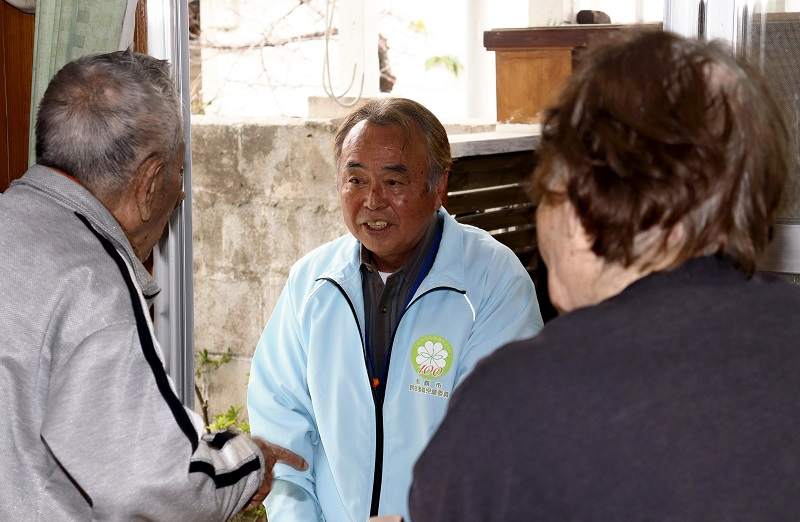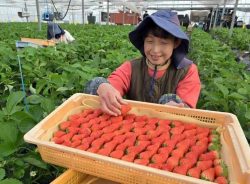
A commissioned welfare volunteer, center, visits a household in Naha on Dec. 26.
21:00 JST, December 31, 2022
Japan is suffering from a severe shortage of commissioned welfare volunteers. About 14,800 positions currently sit vacant across the nation due to difficulties in securing human resources amid the aging population, according to a Yomiuri Shimbun survey.
Welfare volunteers are categorized as part-time local public servants commissioned by the health, labor and welfare minister based on the Commissioned Welfare Volunteers Law. Volunteers are selected every three years after the head of each municipality nominates candidates, and they can also be reappointed.
The volunteers visit elderly people living alone and offer consultation services. They also serve as child welfare volunteers under the Child Welfare Law. Expenses for phone calls and transportation are provided, but the volunteers are not paid for their work.
Commissioned welfare volunteers were newly elected across the nation on Dec. 1. Compared to the same period three years ago, vacant positions have increased by about 3,400 — approximately 30%.
The current shortage is believed to be the worst since World War II.
The quota for commissioned welfare volunteers is set for each area based primarily on the number of households, which have continued to increase, but the aging of the population and other factors have made it difficult to fill the positions. In Tokyo, the prefectures of Osaka and Okinawa, and 11 ordinance-designated cities and core cities, about 10% of quota vacancies were unfilled.
The Yomiuri survey was conducted in December, targeting a total of 129 prefectures, ordinance-designated cities and core cities, all of which responded. The total quota for the prefectures and cities rose by about 240,000, up about 900 from three years ago due to an increase in the number of nuclear families and one-person households. On the other hand, the survey showed there were about 225,100 commissioned welfare volunteers, down by about 2,600. Vacancies were seen to increase in 42 prefectures and 68 cities.
In the survey, the sufficiency-rate-to-quota national average was 93.83%, a fall of 1.41 percentage points. Okinawa Prefecture had the lowest figure at 74.43%, followed by Tokyo at 88.02% and Osaka Prefecture at 89.61%. Among the ordinance-designated cities and core cities, Naha was last at 62.75%, followed by Kawasaki at 80.94% and Nishinomiya, Hyogo Prefecture, at 82.56%.
According to the welfare ministry, the number of vacancies for commissioned welfare volunteers has generally been somewhere between 1,000 and 6,000 since the end of World War II to the 2000s, but these figures have increased steadily since the 2010s. The latest vacancy figure showed an about 2.7-times increase in the past 12 years, compared to 2010 when about 5,400 positions sat vacant.
"Society" POPULAR ARTICLE
-

M4.9 Earthquake Hits Tokyo, Neighboring Prefectures
-

Israeli Tourists Refused Accommodation at Hotel in Japan’s Nagano Pref., Prompting Protest by Israeli Embassy and Probe by Prefecture
-

M7.5 Earthquake Hits Northern Japan; Tsunami Waves Observed in Hokkaido, Aomori and Iwate Prefectures
-

Tsukiji Market Urges Tourists to Avoid Visiting in Year-End
-

M5.7 Earthquake Hits Japan’s Kumamoto Pref., Measuring Upper 5 Intensity, No Tsunami Expected
JN ACCESS RANKING
-

Keidanren Chairman Yoshinobu Tsutsui Visits Kashiwazaki-Kariwa Nuclear Power Plant; Inspects New Emergency Safety System
-

Imports of Rare Earths from China Facing Delays, May Be Caused by Deterioration of Japan-China Relations
-

University of Tokyo Professor Discusses Japanese Economic Security in Interview Ahead of Forum
-

Tokyo Economic Security Forum to Hold Inaugural Meeting Amid Tense Global Environment
-

Japan Pulls out of Vietnam Nuclear Project, Complicating Hanoi’s Power Plans






















